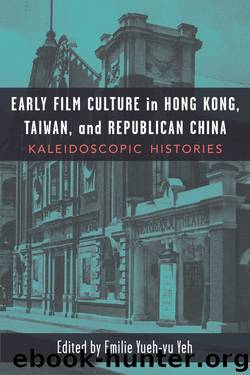Early Film Culture in Hong Kong, Taiwan, and Republican China: Kaleidoscopic Histories by Emilie Yueh-yu Yeh

Author:Emilie Yueh-yu Yeh
Language: eng
Format: epub
Publisher: University of Michigan Press
Published: 2018-05-15T00:00:00+00:00
Cultural Salon of New Elites: The Social and Cultural Role of the Shanghai YMCA
Shanghai became one of the most important commercial ports in China after the Opium War. The Bund, located running along the Huangpu River, which crossed the city vertically and divided it into east and west shores, was Shanghai’s earliest developed area. Important administrative offices of the Municipal Council of International Settlement were located in this area, as well as skyscrapers of large-scale foreign and multinational firms, such as banks and trading companies. Northward from this area, the Garden Bridge was built across the Suzhou River and toward Hongkew, the opposite side of the Bund. In 1900, Robert E. Lewis, an American missionary, opened the Shanghai YMCA in Hongkew with the support of Cao Xuegeng. The early activities of the Association were simple and small-scale; the members held periodical meetings for prayer and gatherings for Bible readings at Lewis’s home on Broadway Road (present-day Daming lu). When established, the Association was anxious that “Shanghai’s culture and society was extravagant, which might wreck young men’s morality”; hence the Association aimed “to plant three disciplines: the education of moral, intellectual, and physical discipline.”12 Although it had only thirty-five members just after establishment,13 it grew rapidly when the meeting venue was transferred to the Bund; in 1902, membership reached more than 650.14
In 1907, the Shanghai YMCA moved its meeting venue to the Bund, No. 120 Sichuan Road. The building consisted of four flours with a modern design; there was a gymnasium with professional equipment at the ground level, and a reading room and library were located at the first level, where electric fans and cold drinks were provided to members during summer.15 Members enjoyed the latest issues of magazines that many elites preferred to read, such as Oriental Magazine, Women’s Magazine, and Educational Magazine, as well as Science, which was edited by the Chinese Association for Science, with the aim of expanding scientific knowledge among a broader range of readers.16 The number of library visitors reached more than one hundred.17 Another feature at the second level was the large hall; located at the west side of the building, this hall was capable of hosting seven hundred people. The “Martyrs’ Hall,” named after the martyrs of the Boxer Rebellion at the turn of the twentieth century, had a stage at the front and furnished theater seats imported from Grand Rapids, Michigan, a city famous for manufacturing furniture.18 In 1915, the hall was also equipped with electric fans, so as to “keep the inside of the hall cool during the high-temperature season.”19 Moreover, the building ran a restaurant that provided both Chinese and Western cuisine, and had a modern stage where the members enjoyed performances of orchestras.20 Overall, there seemed to be no question that the Association had great advantages in terms of its equipment and facilities compared to other educational and entertainment institutes.
Varied institutes for sports with brand-new equipment were another reason why many young people were attracted to the Shanghai YMCA.
Download
This site does not store any files on its server. We only index and link to content provided by other sites. Please contact the content providers to delete copyright contents if any and email us, we'll remove relevant links or contents immediately.
Kathy Andrews Collection by Kathy Andrews(11737)
Thirteen Reasons Why by Jay Asher(8800)
The Red Files by Lee Winter(3368)
How to Do Nothing by Jenny Odell(3235)
The Genius of Japanese Carpentry by Azby Brown(3228)
Stacked Decks by The Rotenberg Collection(2812)
Tattoo Art by Doralba Picerno(2600)
Champions of Illusion by Susana Martinez-Conde & Stephen Macknik(2417)
The Artist's Way Workbook by Cameron Julia(2197)
The Art of Doom by Bethesda(2108)
Calligraphy For Dummies by Jim Bennett(1993)
Creative Character Design by Bryan Tillman(1891)
Botanical Line Drawing by Peggy Dean(1812)
Wall and Piece by Banksy(1783)
The Art of Creative Watercolor by Danielle Donaldson(1777)
One Drawing A Day by Veronica Lawlor(1767)
Art Of Atari by Tim Lapetino(1752)
Pillars of Eternity Guidebook by Obsidian Entertainment(1628)
Happy Hand Lettering by Jen Wagner(1558)
